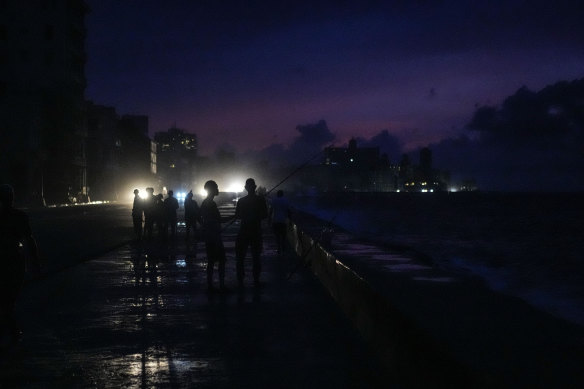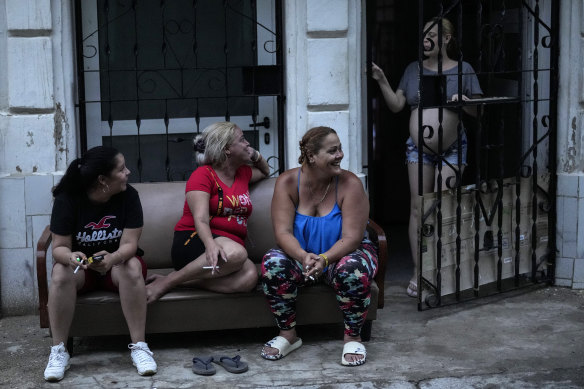This was published 9 months ago
How a country of 10 million people was left without power
By Dave Sherwood
Havana: The entire population of Cuba was plunged into a countrywide blackout following the collapse of one of its major power plants on Friday and authorities had restored only a trickle of power to its grid by the evening.
The vast majority of the country’s 10 million residents were still in the dark on Friday night, but scattered pockets of the capital Havana, including some of the city’s major hospitals, saw lights flicker back on shortly after dark.

People in Havana during a countrywide blackout on Friday.Credit: AP
The Communist-run government had earlier attempted to avert disaster by closing schools and non-essential industries as well as sending most state workers home in a last-ditch effort to keep the lights on after weeks of severe power shortages. Recreational and cultural activities, including nightclubs, were also closed.
But shortly before midday, the Antonio Guiteras power plant, the country’s largest and most efficient, went offline, prompting a total grid failure and suddenly leaving the entire island without power.
The collapse of the national grid underscored the precarious state of the Communist-run country’s infrastructure and economy.
Restoration of service is under way but long-term challenges will remain.

Residents pass the time in Havana on Friday. Schools, non-essential industry, state workplaces and recreational and cultural activities were all closed.Credit: AP
Why did the grid collapse?
Cuba’s electrical grid and oil-fired power plants are obsolete and crumbling, constructed decades ago and scarcely maintained. And because Cuba produces very little fossil fuel of its own – with limited refining capacity – it depends almost entirely on imports to assure adequate generation.
Long-time ally Venezuela slashed fuel shipments to Cuba by half this year as it struggles to assure supply at home. Allies Russia and Mexico have also cut exports to Cuba, forcing the cash-strapped government to seek far pricier fuel on the spot market.
The situation came to a head on Friday, when Cuba’s largest power plant malfunctioned, joining several smaller plants already offline. Foul weather had also stalled the arrival of fuel from tanker ships offshore, starving the island’s power plants. The combination prompted the entire grid to collapse.
Is the United States at fault?
Cuba has long blamed the US Cold War-era trade embargo as well as more recent sanctions by former President Donald Trump for its electricity woes, allegations repeated by Cuban President Miguel Diaz-Canel on Thursday.
The US denies any role in the recent grid collapse.
US sanctions, however, do complicate financing of fuel purchases and spare parts for Cuba. They also scare off many oil tankers, forcing Cuba and Venezuela to depend on their own obsolete fleet for transportation.
But Cuba’s government has also acknowledged its own shortfalls. Rampant corruption, bureaucracy and vast inefficiencies have brought its state-run economy to its knees, leaving the government with no surplus funds to update its electrical grid.
How are Cubans responding?
Life in Cuba has become extraordinarily difficult. Millions suffer daily without electricity in the sultry Caribbean climate, leading to soaring levels of mosquito-borne illness. Hundreds of thousands of Cubans are now without water, in part due to power outages that cripple water supply and infrastructure.
Vast and growing shortages of food, fuel and medicine also complicate life on the island. Months of hours-long daily blackouts have wiped out precious stores of frozen foods, putting a majority in ever more precarious situations. Frustration is nearly universal.
Under a government that does not tolerate protests, many make their unhappiness known by emigrating, contributing to a record-breaking exodus off the island since 2020.
What solutions has the Cuban government proposed?
Cuba’s government says it has begun investing in a long-term plan to produce a growing percentage of its electricity from renewable sources, primarily solar. It is also investing to produce more crude oil domestically.
State-run media this week reported that 26 solar farms were under construction throughout the country, with the goal of installed capacity of 1000 megawatts, or about a third of existing demand, in two years. Another similar project is due to be completed by 2031.
Economic crisis, fuel shortages and funding shortfalls have slowed progress, forcing it to continue to rely on its obsolete power plants in the near term.
Has a grid collapse happened before?
Yes. Following the passage of Hurricane Ian in September 2022, Cuba’s grid collapsed, leaving the entire country without power for several days.
Authorities eventually re-established service, but not before protests broke out in various cities across the island, including Havana.
Reuters
Get a note directly from our foreign correspondents on what’s making headlines around the world. Sign up for our weekly What in the World newsletter.